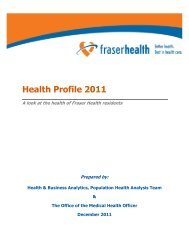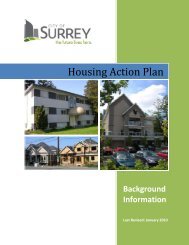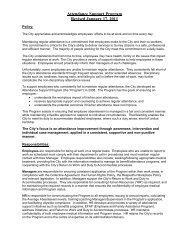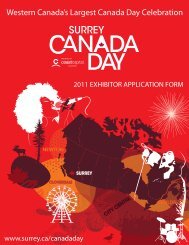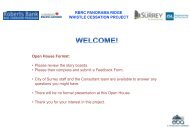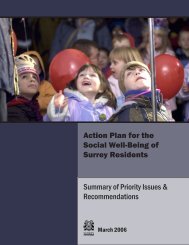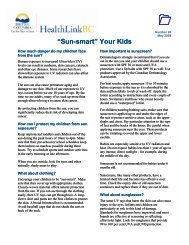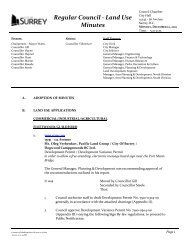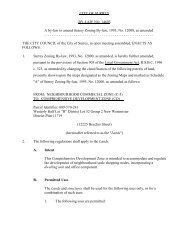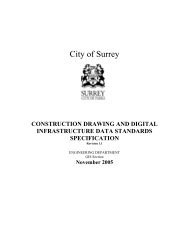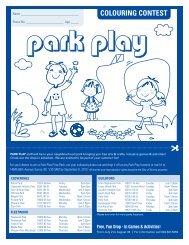Blackie Spit Park: Wildlife Habitat Enhancement Plan - City of Surrey
Blackie Spit Park: Wildlife Habitat Enhancement Plan - City of Surrey
Blackie Spit Park: Wildlife Habitat Enhancement Plan - City of Surrey
Create successful ePaper yourself
Turn your PDF publications into a flip-book with our unique Google optimized e-Paper software.
3.1.1 <strong>Wildlife</strong> Species Management Goals for <strong>Park</strong><br />
A goal <strong>of</strong> the Master <strong>Plan</strong> is to protect the long-term environmental integrity <strong>of</strong> <strong>Blackie</strong> <strong>Spit</strong> while<br />
providing opportunities for community and nature-based uses. Those nature-based uses are<br />
dependent on the habitats that occur in the park. In general, the habitats (excluding areas primarily<br />
used by people) include intertidal; dyked, former agriculture; dry dredgate; moist dredgate; managed<br />
dykes; and ditches.<br />
Within the context <strong>of</strong> the general habitat complexes occurring at <strong>Blackie</strong> <strong>Spit</strong> <strong>Park</strong>, and in order <strong>of</strong><br />
priority, the wildlife species management goals are for species adapted to<br />
• Intertidal habitats (e.g., migratory birds)<br />
• Open, dry, sparsely vegetated habitats (e.g., migratory and wintering passerines, breeding birds)<br />
• Old-field habitats (e.g. small mammals, avian and mammalian predators)<br />
• Transitional habitats – interspersions <strong>of</strong> shrubs, small trees and grasslands (e.g., sparrows, small<br />
roaming passerines, medium-sized mammals)<br />
• Deciduous or mixed, deciduous-dominated woodlot and hedgerow (e.g., foraging, roosting and<br />
nesting raptors, especially buteos and accipiters; resident woodpeckers and sparrows; breeding<br />
migratory flycatchers, thrushes, vireos, and warblers)<br />
• Mixed, coniferous-dominated woodlot (e.g. foraging raptors including accipiter hawks and small<br />
owls; resident woodpeckers, small roaming passerines, thrushes, and sparrows; breeding<br />
migratory passerines)<br />
• Ditches and intensively managed dyke sides (insects, insectivorous birds, seed-eating birds,<br />
piscivorus birds, aquatic birds and mammals).<br />
3.1.2 <strong>Habitat</strong> Management Objectives for <strong>Park</strong><br />
<strong>Habitat</strong> management objectives fall into one <strong>of</strong> three categories: enhancement activities (generally,<br />
vegetation management), invasive plant species management, and people management.<br />
3.1.2.1 <strong>Habitat</strong> <strong>Enhancement</strong> Objectives<br />
<strong>Habitat</strong> management activities for a Management Unit (MU) (Figure 2) frequently entail vegetation<br />
enhancements such as planting species <strong>of</strong> shrubs and trees, but may involve soil enhancement,<br />
periodic vegetation control, the placement <strong>of</strong> coarse woody debris, drainage, agricultural field<br />
renovation, or other activities.<br />
3.1.2.2 Invasive <strong>Plan</strong>t Species Management<br />
Several non native plant species have become established in <strong>Blackie</strong> <strong>Spit</strong> <strong>Park</strong> that tend to spread and<br />
become dominant at the expense <strong>of</strong> native species and at the expense <strong>of</strong> habitat diversity. Such<br />
species may never be eliminated, and doing so is not necessarily an objective because they usually do<br />
provide some wildlife habitat value or have some human interest value in themselves. Ongoing<br />
control efforts are, however, necessary in order to realize optimum habitat and wildlife value. Such<br />
<strong>Blackie</strong> <strong>Spit</strong> <strong>Park</strong>: <strong>Wildlife</strong> <strong>Habitat</strong> <strong>Enhancement</strong> <strong>Plan</strong> – PART 1: Background and Summary 5



